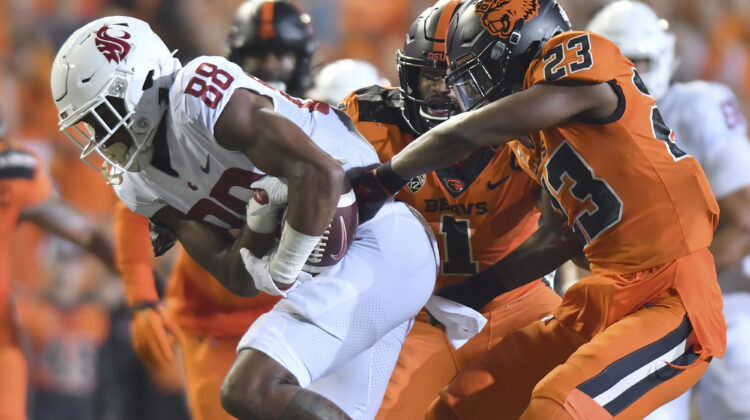As the final Pac-12 football season nears a conclusion, the conference is approaching resolution on another contested issue: control of hundreds of millions of dollars in revenue and assets.
The lawsuit filed by Washington State and Oregon State in early September is scheduled for a critical hearing on Tuesday in Whitman County (Wash.) Superior Court, where Judge Gary Libey could determine the makeup of the governing board and, thus, control of the finances.
Or maybe he won’t rule on Tuesday.
Or maybe the process will end before the hearing even begins.
The outlook is uncertain, but the stakes are clear — and substantial.
The Cougars and Beavers believe the 10 outbound schools relinquished their board positions when they agreed to join other conferences starting next summer.
The 10 outbound schools believe they have not violated the Pac-12’s bylaws and should retain their board seats.
The Cougars and Beavers believe that if allowed to remain on the board, the departing schools could vote as a bloc to dissolve the conference and split the assets equally among the 12 universities.
The 10 outbound schools believe that if given control of the board, WSU and OSU would keep all the conference’s assets for themselves, including more than $400 million in revenue generated this school year, when all 12 are competing under the Pac-12 banner.
Time is essential for WSU and OSU. It has been 100 days since the Pac-12 collapsed on Aug. 4, and they need clarity on the governance of the conference — and the resources available — in order to plot their strategy for the 2024-25 competition season and beyond.
How might the situation unfold?
Let’s dive in …
Scenario I: Settlement via mediation
Context: The plaintiffs and defendants agreed to enter mediation in early October. There have been no leaks thus far, so it’s difficult to ascertain the level of progress, or lack thereof.
However, we can view the situation through the lens of … wait for it … common sense.
To the Cougars and Beavers, the dispute is over both money and governance. They want control of the Pac-12’s long-term assets, including NCAA Tournament units worth about $60 million and, potentially, $80 million in Rose Bowl revenue. Also, they want sole possession of the governing board in order to determine their own futures and prevent the 10 from dissolving the conference. With the board seats, of course, would come control over the 2023-24 revenue.
(One option under consideration: Competing as a two-school league for two years, then adding teams from the Mountain West.)
To the departing schools, the dispute is over money. Based on court filings, they are less concerned with the conference’s future assets and more focused on their shares of the 2023-24 revenue. The figure cited is $420 million, or about $35 million per school.
As we see it, there is room for compromise:
The 10 outbound schools relinquish their board votes, allowing WSU and OSU to control the future of the conference; meanwhile, WSU and OSU agree to distribute most, if not all of the 2023-24 revenue.
How much? We have no idea. Maybe the 10 outbound schools agree to take $25 million per campus, or $30 million.
Why wouldn’t they proceed with the court fight and attempt to grab every last dime of their full $35 million shares?
Because they don’t want to spend the money on billable hours or risk losing in court and ending up with nothing — no control, no current-year revenue and no long-haul assets.
Likelihood of a settlement: 50 percent
Scenario II: The case concludes Tuesday
Context: The crux of the dispute is simple, with WSU and OSU opposing the 10 outgoing schools. But the details are tricky. The named defendant isn’t a school — it’s the conference itself, along with commissioner George Kliavkoff. (Yes, he’s still the commissioner.)
Meanwhile, one school has joined the fray through a motion to intervene: Washington, because it’s located in the state where the lawsuit was filed.
Acting on behalf of all 10 departing schools, the Huskies oppose the request for a preliminary injunction that would give board control to WSU and OSU.
Libey’s courtroom is located 15 miles from WSU’s campus. He already ruled in favor of the Cougars and Beavers in September, granting their request for a temporary restraining order that brought board business to a halt.
If there is no settlement and the hearing proceeds on schedule Tuesday (2 p.m.), Libey is expected to rule on the preliminary injunction request.
A decision could come at the end of the hearing, or he could opt to review the case for a period of time.
Either way, Libey, like many judges, could signal which way he’s leaning during the proceedings. And WSU has the home-court advantage.
That said, a decision won’t mean resolution.
Likelihood of conclusion Tuesday: 0.1 percent (assuming no settlement)
Scenario III: The loser appeals
Context: It’s difficult to sketch a scenario in which Libey’s ruling carries enough nuance to satisfy both sides.
As a result, multiple sources familiar with details of the case expect the loser to appeal Libey’s ruling immediately to the Washington Supreme Court in Olympia.
In fact, this might have been Washington’s plan all along.
Why? Because an appeal would turn a road game (15 miles from Pullman) into a neutral court affair.
It might even give the defendants an advantage. Olympia is an hour from Seattle. There’s a strong chance that presiding judges will have UW ties.
How long could an appeal take? Possibly several weeks; potentially several months.
Likelihood of an appeal: 99.9 percent (assuming no settlement)
Related posts:

(AP Photo/Marcio Jose Sanchez)
Wilner Hotline – Pac-12 Moving Out of Bay Area
(AP Photo/Ralph Freso, File)
Brandon Huffman Pac-12 Recruiting Notebook
(AP Photo/Ralph Freso, File)
Pac-12 power ratings: What happens when you have a collection of good teams? Big games, that’s what
(AP Photo/Amanda Loman)
Pac-12 picks: Our deep dive into the Oregon-UCLA point spread (ignore the Georgia result!) and breakdown of every Week Eight game
